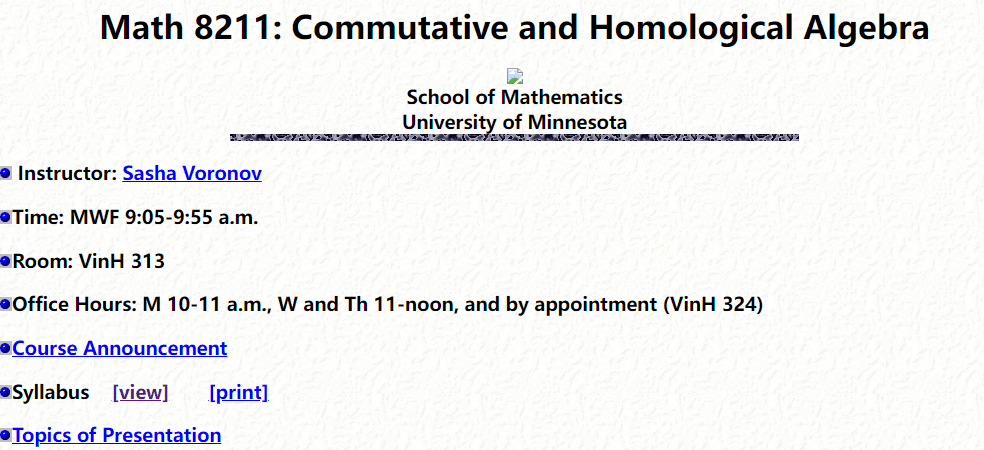MY-ASSIGNMENTEXPERT™可以为您提供users.cse.umn.edu Math8211 Commutative Algebra交换代数课程的代写代考和辅导服务!

Math8211课程简介
TEXT: Commutative algebra. With a view toward algebraic geometry by David Eisenbud, 1995.
Prerequisite: Math 8201-02 General Algebra or some previous experience with groups, rings, and fields.
DESCRIPTION: Commutative algebra stands at the crossroads of algebra, number theory, and algebraic geometry. It is subsumed by algebraic geometry as the local study of algebraic varieties, somewhat similar to analysis in R^n succumbing to the theory of manifolds. Homological algebra is a powerful algebraic tool used in many fields of mathematics, including commutative and noncommutative algebra, group theory, Lie theory, several complex variables, geometry and topology, PDE, combinatorics, functional analysis, numerical analysis, and mathematical physics, to name a few.
Prerequisites
CONTENT: In the Fall Semester, we will study commutative algebra. This will include commutative rings and modules over them, Noetherian rings, Krull dimension theory, Noether normalization, the so-called Nullstellensatz, the spectrum of a ring, rings of fractions and localization, primary decomposition, discrete valuation rings, normal integral domains, and regular local rings. The geometric view of a commutative ring as the ring of functions on a space will be emphasized.
The homological algebra part of the course will be taught in the Spring Term by Bernard Badzioch. The topics will include complexes, homology, resolutions and derived functors. These notions will be put into the context of two different axiomatic approaches to homological algebra: via triangulated categories and via closed model categories. Additional topics will include Koszul complex, Hochschild homology and cyclic homology. Applications to commutative algebra (such as the notion of depth and Cohen-Macaulay rings), algebraic geometry and topology will be discussed.
Math8211 Commutative Algebra HELP(EXAM HELP, ONLINE TUTOR)
If $R$ is any integral domain with quotient field $Q$, prove that
$$
(Q / R) \otimes_R(Q / R)=0
$$
Solution. The typical element of $Q / R$ can be written as a coset $\frac{a}{b}+R$ with $b \neq 0$ and
$$
\begin{aligned}
\left(\frac{a}{b}+R\right) \otimes_R\left(\frac{c}{d}+R\right) & =\left(\frac{a}{b d} d+R\right) \otimes_R\left(\frac{c}{d}+R\right) \
& =\left(\frac{a}{b d}+R\right) \otimes_R\left(d \frac{c}{d}+R\right) \
& =\left(\frac{a}{b d}+R\right) \otimes_R(c+R) \
& =\left(\frac{a}{b d}+R\right) \otimes_R 0 \
& =0 .
\end{aligned}
$$
This solution is mostly correct, but there is one small issue in the second to last line. It should be $\left(\frac{a}{bd}+R\right) \otimes_R (c+R) = 0$ instead of $\left(\frac{a}{bd}+R\right) \otimes_R 0 = 0$.
To see why, note that $\left(\frac{a}{bd}+R\right) \otimes_R (c+R)$ is a tensor product of two non-zero elements, since $b,c \neq 0$ (otherwise the cosets $\frac{a}{b} + R$ and $\frac{c}{d}+R$ would not be in $Q/R$). Therefore, we cannot simply conclude that the tensor product is $0$ based on the fact that one of the factors is $0$. Instead, we need to use the definition of the tensor product to compute the result.
Here is the corrected solution:
The typical element of $Q/R$ can be written as a coset $\frac{a}{b}+R$ with $b \neq 0$ and
$\begin{aligned}\left(\frac{a}{b}+R\right) \otimes_R\left(\frac{c}{d}+R\right) & =\left(\frac{a}{b d} d+R\right) \otimes_R\left(\frac{c}{d}+R\right) \ & =\left(\frac{a}{b d}+R\right) \otimes_R\left(d \frac{c}{d}+R\right) \ & =\left(\frac{a}{b d}+R\right) \otimes_R(c+R) \ & =\left(\frac{a}{b d} \cdot c+R\right) \otimes_R(1+R) \ & =\left(\frac{a c}{b d}+R\right) \otimes_R(1+R) \ & =\left(\frac{a c}{b d} \cdot 1+R\right) \otimes_R(1+R) \ & =\left(\frac{a c}{b d} \cdot 1\right) \otimes_R(1+R)+R \otimes_R(1+R) \ & =\frac{a c}{b d} \otimes_R 1+1 \otimes_R 1+R \otimes_R(1+R) \ & =\frac{a c}{b d} \otimes_R 1+1 \otimes_R 1+R \otimes_R 1+R \otimes_R R \ & =\frac{a c}{b d} \otimes_R 1+1 \otimes_R 1+0+0 \ & =\frac{a c}{b d} \otimes_R 1+1 \otimes_R 1 \ & =0 .\end{aligned}$
The fourth line follows because $c+R$ is the same coset as $d(c/d)+R$ (since $d \neq 0$), and the fifth line follows from the distributive law for tensor products. The last two lines follow from the fact that $R \otimes_R 1 = 0$ and $1 \otimes_R 1 = 0$, which are consequences of the fact that tensor products commute with quotients (see, for example, Proposition 2.6 in Atiyah and Macdonald’s “
Let $\left{e_1, e_2\right}$ be a basis of $V=\mathbb{R}^2$. Show that the element $e_1 \otimes e_2+e_2 \otimes e_1$ in $V \otimes_{\mathbb{R}} V$ cannot be written as a simple tensor $v \otimes w$ for any $v, w \in \mathbb{R}^2$.
Solution. If it could be so written it would be
$$
e_1 \otimes e_2+e_2 \otimes e_1=\left(a e_1+b e_2\right) \otimes\left(c e_1+d e_2\right)=a c e_1 \otimes e_1+a d e_1 \otimes e_2+b c e_2 \otimes e_1+b d e_2 \otimes e_2
$$
The four tensors $e_i \otimes e_j$ on the right are a basis for the tensor product, so we deduce $a c=0=b d$ and $a d=1=b c$. One of $a$ and $c$ must be 0 , so the second equations cannot be satisfied if this is so. The tensor cannot be so written.
Alternative Solution: Suppose for a contradiction that there exist $v, w \in \mathbb{R}^2$ such that $e_1 \otimes e_2 + e_2 \otimes e_1 = v \otimes w$. Then we can express $v$ and $w$ in terms of the basis $\left{e_1, e_2\right}$ as $v = a e_1 + b e_2$ and $w = c e_1 + d e_2$ for some $a, b, c, d \in \mathbb{R}$.
Substituting these expressions into $v \otimes w$, we get \begin{align*} v \otimes w &= (a e_1 + b e_2) \otimes (c e_1 + d e_2) \ &= ac(e_1 \otimes e_1) + ad(e_1 \otimes e_2) + bc(e_2 \otimes e_1) + bd(e_2 \otimes e_2). \end{align*} Comparing coefficients with the expression $e_1 \otimes e_2 + e_2 \otimes e_1$, we see that $ad = bc = \frac{1}{2}$ and $ac = bd = 0$. But this implies that at least one of $a$ or $c$ is $0$, and the other is nonzero. Without loss of generality, suppose $a = 0$ and $c \neq 0$. Then $ac = 0$ implies that $d = 0$, and so $ad = 0$, a contradiction.
Therefore, $e_1 \otimes e_2 + e_2 \otimes e_1$ cannot be written as a simple tensor $v \otimes w$ for any $v, w \in \mathbb{R}^2$.

MY-ASSIGNMENTEXPERT™可以为您提供UNIVERSITY OF ILLINOIS URBANA-CHAMPAIGN MATH2940 linear algebra线性代数课程的代写代考和辅导服务! 请认准MY-ASSIGNMENTEXPERT™. MY-ASSIGNMENTEXPERT™为您的留学生涯保驾护航。

